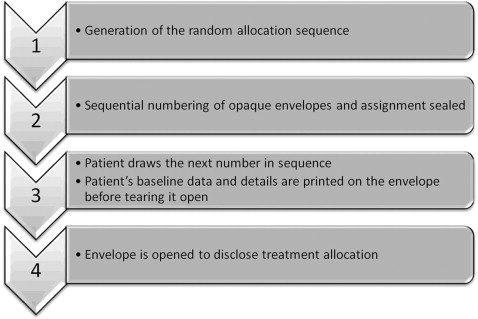Randomization consists of 3 steps: generation of the random allocation sequence, allocation concealment, and implementation of the random allocation sequence. In the previous 2 articles, we discussed the methods to generate the random allocation sequence (the Table summarizes these methods); in this final article on randomization, we will discuss allocation concealment and implementation of randomization.
| Advantages | Disadvantages | |
|---|---|---|
| Simple randomization | Simple to implement Unpredictable |
Unequal sizes of trial arms are common Cannot balance on baseline characteristics, especially in small trials |
| Blocked randomization | Ensures balance in trial arms at all times | Assignment can be predicted if nonvarying, small blocks are used, especially when blinding is not feasible Cannot balance on baseline characteristics, especially in small trials |
| Stratified randomization | Ensures balance in trial arms when combined with blocking Balances on important baseline characteristics that are potential outcome predictors |
Overstratification, many subgroups, and imbalances due to incomplete blocks Assignment can be predicted if nonvarying, small blocks are used, especially when blinding is not feasible Identification of participants before group assignment is necessary |
| Minimization | Ensures balance in trial arms Balances on important baseline characteristics that are potential outcome predictors |
Complex, especially when several predictors are considered Knowledge of previous allocations is required Not strictly random, but a random element could be included |
Allocation concealment is the means to guarantee that the generated randomization lists and consequently the treatment allocations of the trial participants cannot be known or predicted by all involved persons. These include patients, investigators, and other personnel engaged in the study. The objective of allocation concealment is to reduce selection bias, and it can always be applied. Knowing or being able to predict the next treatment allocation might lead to subversion of the randomization in a way that validates the preconceptions of the investigators. For example, if we are conducting a study to compare time to alignment between conventional and self-ligating appliances, lack of allocation concealment could permit a biased investigator to undermine randomization and assign patients with more crowding to the group that he or she does not favor. In this manner, the ensuing selection bias will falsely overestimate or underestimate the effect of appliance type on the alleviation of crowding. In other words, if the investigator favors conventional appliances, he or she might randomize patients with more severe crowding to the self-ligating group, thus making the conventional arm appear to reach alignment in a shorter time. Studies on allocation concealment have shown that lack of allocation concealment has been associated with greater and biased treatment effects.
Allocation concealment should not be confused with blinding, which refers to whether patients and investigators know or do not know which intervention has been allocated. Allocation concealment is always feasible, whereas blinding is not always possible. The best method to achieve allocation concealment is to use an independent and centralized assignment protocol that does not involve any persons associated with the trial. With this method, the randomization lists are generated and held securely in remote locations, thus reducing the chance of peeking at treatment assignments. With a centralized treatment assignment, an eligible and consenting participant, after the recording of his or her baseline characteristics, will be assigned to the treatment group by calling the randomization center to receive the treatment assignment. It is clear from this example that neither patients nor researchers can predict the next allocation; this ensures allocation concealment.
If external treatment allocation is not available, a simple and common method is to enclose assignments in sequentially numbered, opaque envelopes. Opacity can be implemented by inserting the paper with the assignment into foil, and this ensures that no involved person can see the assignment by looking at the envelope under a light. The sealed envelope method, although simple, carries some pitfalls such as the danger that envelopes could be opened and resealed. Therefore, it is recommended that (1) the patient’s name and baseline information are written on the envelope before opening it; (2) the envelope is torn open instead of being unsealed; and (3) the envelopes are stored in a different and secret location from the trial site. It is also recommended that, after treatment allocation, the envelopes should be securely stored for assessment of allocation concealment procedures. Figure 1 shows a typical sequence of events for treatment allocation with opaque concealed envelopes.





